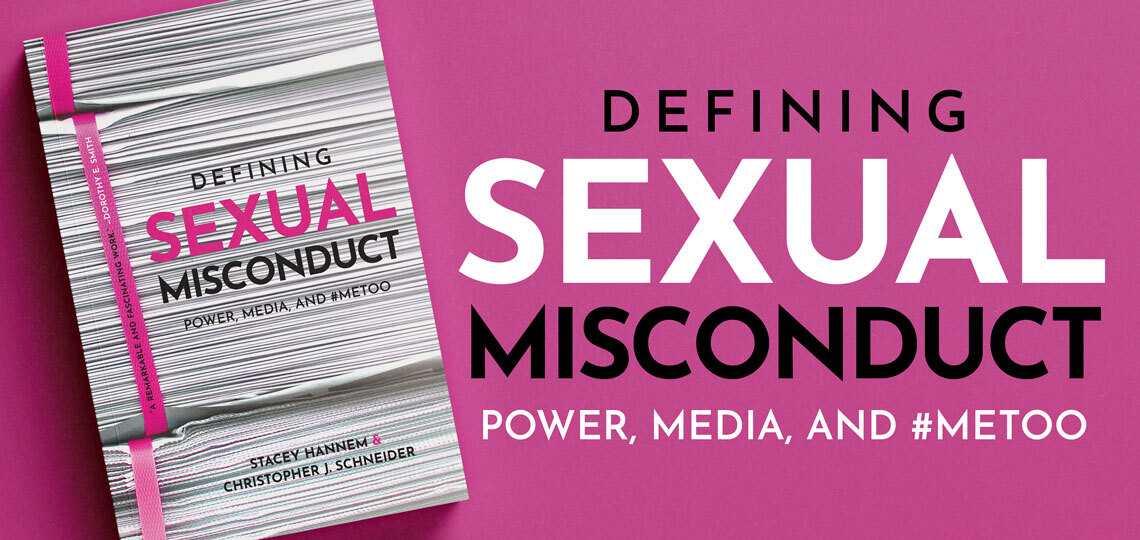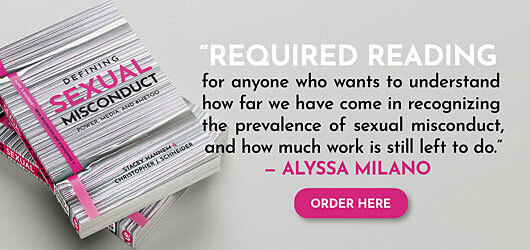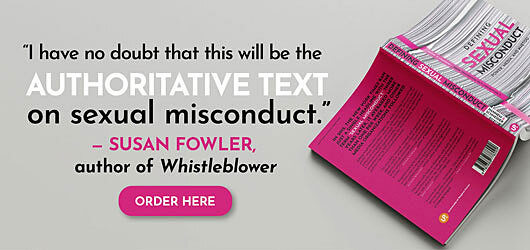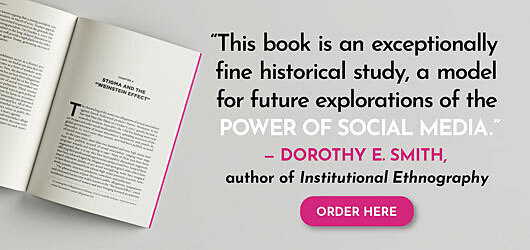“Defining Sexual Misconduct” authors explore the roles power and media play in accountability

Executive Editor Matt Sutherland Interviews Stacey Hannem and Christopher J. Schneider, Authors of Defining Sexual Misconduct: Power, Media, and #MeToo
Afterward, when they are finally ready to talk, victims of sexual trauma face daunting language challenges to describe what happened. And that alone may keep them from speaking up. This is especially true when a sexual harm might not meet the legal threshold of a crime like assault or harassment—cat-calling, leering, creepy hugging, for example, and so much more short of serious, criminal behavior.
But women, and it’s mainly women, must feel empowered to talk about those unacceptable experiences. An accessible language, understood by all, is vitally important because it offers a way to talk about trauma and to have the behavior recognized as harmful.
To help us better understand the power of language to describe sexual harm that doesn’t meet the legal standards of a crime, we asked Foreword’s executive editor, Matt Sutherland, to connect with Stacey Hannem and Christopher Schneider, authors of the recently released Defining Sexual Misconduct: Power, Media, and #MeToo.
We hope you enjoy this important interview.
A careful reading reveals what fierce advocates you both are for victims of sexual misconduct. Please tell us a bit about your respective backgrounds and the path to writing this book?
The book is a product of the marriage of our combined research interests. Neither one of us could have written the book as a sole authored monograph. Stacey’s research background is in how criminal law contributes to marginalization, with a particular focus on sex workers. She has also studied gendered and sexual violence. Chris’s academic background focuses on media research and analysis. We believed that Trump’s political aspirations were over when the Access Hollywood tape became public and we were completely baffled, like many people, when Trump was elected President.
We spent many hours discussing the why and how of it all. It wasn’t before long that we started to sketch out a research paper to answer the question about how Trump was elected (what would become an earlier version of chapter 3). Just as we started drafting our paper, the Weinstein allegations were made public and then #MeToo happened. We thought that these circumstances had to be connected and we were particularly intrigued by the vast difference in the public response to the allegations against Weinstein, as compared to Trump. We decided we had to write a book about it.
You write that this book may be unique, partly because of the fact that one of you is female, and the other male, offering “separate gendered viewpoints.” Can you talk specifically about where those viewpoints differed, or even perhaps clashed?
How a person experiences the world is very much influenced by their positionality. As an example, consider how little girls and boys are taught from a very young age about their “appropriate” gendered roles and the ways that such learning can manifest later in life. As a man, tall and broad-shouldered, bearded, tattooed—perhaps we might call his look hypermasculine—Chris does not think very hard about his personal safety when walking alone at night or necessarily about his surroundings when in a room full of other men. This is a taken-for-granted way of being in the world.
Many women simply do not have this luxury and must grapple with the disproportionate reality and likelihood of experiencing sexual violence in their lifetimes. We do not mean to suggest that men do not experience sexual violence, they of course do, but rather, that women are usually much more aware of the possibility, an awareness that is often reflected in their choices and ways of being in the world. As a sociologist and feminist, Chris has some knowledge of the statistics on sexual violence but lacks the lived experience-as-awareness. Our different gendered positions informed many of our discussions, but our differences were less about clashing per se, since we are sympatico in identifying as feminists, and more about providing clarity to one another.
When Trump claimed that the Access Hollywood tape was “just locker room talk,” Chris, having played men’s sports (baseball) for many years had spent some time in men’s locker rooms, and was able to provide insight to Stacey about crude comments and the misogynistic tone of locker rooms (although he had never heard of other men bragging about sexual assaults in any locker room he was in). We also had lengthy discussions about the emergence of the “NotAllMen” critique and the personal tension that this poses for feminist men in trying to be reflexive about their participation in a patriarchal culture. These discussions added some nuance to our analysis of the so-called “grey zone” and responsibilization for consent in sexual encounters, in chapter 6 in particular.
Donald J. Trump is a singular figure, of course, but you write that his 2016 presidential run provided the right conditions for harmed women to come forward with their stories. The foundation for Trump’s rise has been heavily discussed from a nationalist angle, but how about resistance to #MeToo? Was some of this Trump inspired?
While we have not directly investigated resistance to #MeToo because of Trump, we can certainly speculate that much of the resistance to #MeToo was inspired by Trump. For instance, consider Trump’s nonsensical declaration: “It is a very scary time for young men in America, where you can be guilty of something you may not be guilty of.” Such statements are unhelpful because they redirect attention away from the issue of systemic sexual violence, on the one hand, but also bring up important matters that we cannot ignore like due process, which is especially a concern for many who resist #MeToo, on the other hand. We address the issue of due process and the pursuit of justice in the wake of the #MeToo movement in the concluding chapter of our book.
Sexual misconduct covers a great deal of behavior, including a fair amount that isn’t illegal or criminal. This is encouraging in that calling out inappropriate, creepy, disgusting activity deserves attention so that it is no longer acceptable. Please help us understand how—and by whom—that spectrum of non-criminal behavior is being defined and discredited?
The term “sexual misconduct” is ambiguous. As an umbrella term, sexual misconduct has been used to refer to both criminal sexual assault and consensual sexual encounters and everything in between, as we detail in the first chapter of our book. The social structures in which women find themselves have historically been created and defined by men, the law is a prime example. The legal recognition of sexual harassment and other forms of sexualized violence was hard-fought by courageous feminists, and it ultimately took years. While the law now recognizes harmful behaviours like sexual harassment, the logic is that those behaviours not recognized as illegal must therefore be less harmful or not harmful at all, which is just profoundly untrue.
One of the outcomes of #MeToo and related movements was taking the recognition of sexual harms out of the legal binary, allowing women to define harms as they experienced them, a power held so long by men. The spectrum of non-criminal behaviours is largely defined by women and discredited by men because when women accuse men of sexual misconduct, a term with no legal recognition, men cannot use the traditional structures of the legal system to defend themselves. A thread that runs across the case studies we offer in our book is the gradual shift toward greater inclusion of women’s standpoints in the discourse that defines their experiences. Understanding all of these diverse experiences (from cat-calling to sexual assault) under the umbrella of sexual misconduct allows us to see how they are culturally connected, and how tolerating so-called “minor” harms creates the social climate of toxicity that leads to more serious criminal violations.
The way we label sexual misconduct is heavily impacted by the language available to describe the experience. Can you expand on this observation and explain why it matters so profoundly? As an example, the term “sexual misconduct” seems to be preferred by far more women in their attempts to describe their own experiences of sexualized harm, rather than sexual harrassment or assault. In that sense, it allowed more women to enter the conversation, an important and positive development.
Sexual harassment was named in 1975 and spread around the world as a way for women to talk about cross-cultural patterns of abusive behaviour by men in the workplace. This does not imply that such abuse behaviours did not exist before 1975, they of course did. Rather, the naming and recognition of abusive behaviours allowed women to identify as having experienced sexual harassment through the lens of the law. A situational irony, however, occurs whereby women begin to identify less with sexual harassment due to uncertainty as to which behaviours necessarily meet the legal standard of definition of sexual harassment. The language of sexual misconduct which emerges through media over a series of decades as detailed in the book matters precisely because it provides an accessible language to all women to name and recognize harm. Having the language to describe a sexual harm that does not necessarily meet the legal threshold of harassment or assault (or that women don’t realize meets the threshold) is important because it provides a way of talking about that harm and recognizing it as harm.
Did media usage of the term “sexual misconduct,” influence the creation of laws in a way that “sexual harassment” or “sexual assault” did not?
Media usage of sexual misconduct did not so much influence the creation of new laws per se as it probably contributed to recent shifts in the application of existent laws. As one example, we might consider that the onus of proving a case of sexual harassment typically relied on the complainant establishing that alleged questionable behaviours were in fact “unwelcome.” Recent evidence suggests that the onus is starting to shift to the respondent to demonstrate that consent had been received by the complainant, so that the burden is upon the respondent to make a case that the behaviours in question were not unwelcome. Another example of the cultural influence of sexual misconduct is the move away from non-disclosure agreements in cases of sexual misconduct.
For decades now, coverage of sexual misconduct has steadily increased in the media, as you document. Is it possible to know whether the incidence of sexual misconduct has decreased as a direct correlation? What about since the #MeToo movement began? Has that notoriety influenced male behavior?
We cannot say with empirical certainty whether there is a correlation between media coverage of sexual misconduct and incidents of sexual misconduct. We do know that reports of sexual misconduct have increased. For instance, reports of sexual misconduct at the University of British Columbia are up 83 percent over the previous year. #MeToo has contributed to increased reporting of sexual violence, sexual harassment, and other sexual harms, and this has been documented. The notoriety has surely influenced some male behaviour, but more men need to hold other men to account. The fact that sexual misconduct is still so pervasive suggests that much work remains on the part of men who must actively practice what we could call anti-sexual misconduct to counter all forms of sexual violence if we are to work toward a safer and more inclusive society .
You cite research showing that in claiming a personal narrative about sexual violence via social media, victims often contradict police reports, which serves to erode police legitimacy. Would you comment on this, as it relates to the other ways law enforcement’s reputation has taken a hit recently?
A great deal of police legitimacy concerns how police maintain control over their public image in media which is largely where the public learns about police actions, like arrest figures, police shootings, brutality, etc. Law enforcement’s reputation has taken a hit recently in large part because of viral videos that contradict police statements. The most notorious example was the police murder of George Floyd. Consider the initial statement released by the Minneapolis Police indicating that Mr. Floyd’s death was a result of a “medical incident.” A grotesque lie, as illustrated by the viral video of his horrific murder.
Historically, police have often reproduced rape myths in their investigation techniques and have played a significant role in silencing victims of sexual violence by creating a hostile environment for reporting. Recent investigations into so-called “unfounded” cases of sexual assault in Canada have found that significant numbers of those reports of sexual assault were coded by police as unfounded and closed without adequate investigation, or even in the face of evidence. Police have a long way to go in improving their responses to people who report sexual assault and creating a safe environment for disclosure.
All victims of sexual misconduct aren’t created equal, you point out in a discussion of “ideal victims” and the factors that influence and validate victim status—an arbitrary and excruciatingly nuanced process. Yes, the media plays a major role, but talk about social media and how a victim’s own voice is changing the dynamic?
Social media continue to be important in validating a victim’s personal experience with sexual misconduct. However, such validation is complicated by other factors including celebrity status or lack thereof, and relatedly, algorithms, which boost some messages (like celebrity tweets) and devalue others. However, there is strength in numbers, as is often said. #MeToo linked millions of personal disclosures by regular people (i.e., not celebrities) across the world. What this did was provide legitimacy to sexual misconduct as a systemic issue as it would be impossible for millions of people around the world to simultaneously coordinate such disclosures and to publicly lie about their stories on such a massive scale. This in turn legitimized individual experiences on social media.
Mainstream media can also do significant harm to victims of sexual misconduct, but journalistic standards do have a positive effect, right? Can you talk about that landscape and the discussions in editorial boardrooms about how to cover these stories?
Mainstream media bring more attention to sexual misconduct, and this is of course good. However, the term “sexual misconduct” has been justifiably criticized as a type of softened expression used by news journalists which can undermine the severity of more serious forms of sexual violence like sexual assault. One reason for this language usage in terms of covering such stories, as we detail in our book, is due primarily to the liability concerns of news organizations. To avoid legal liability, journalists are instructed to use and cite the language in police reports, and when that language is not available, say in cases where police reports either do not exist or have not been made available, to default to “sexual misconduct,” since it is a relatively neutral term without legal meaning.
With Clarence Thomas, Bill Clinton, Donald Trump, and Brett Kavanaugh in mind, a credible accusation of sexual misconduct against political figures seems to have mixed record in influencing voters. Can we simply write that off to the partisanship of voters—see no evil, hear no evil—or is something else going on?
Our analysis of voter responses (in chapter 3) to allegations of sexual misconduct found some interesting and troubling trends, much of which can be directly attributed to the partisanship of voters. For instance, allegations against progressive candidates who present publicly as allies to women are far more likely to be met with censure and to destroy campaigns than allegations against conservatives. This can be explained in part because voters with progressive political leanings tend to take issues of sexual violence more seriously and thus hold their political representatives accountable for their alleged behavior. Conservative voters, however, tend to prioritize other issues like restricting abortion over allegations of sexual misconduct and do not hold politicians to the same standards, especially if the allegations are not perceived as necessarily criminal.
In chapter 6, you set out to answer a concise question: “What kinds of allegations are understood to rise to the bar of sexual misconduct, and what kinds of allegations are minimized or taken less seriously?” So, what type of behavior fell into the “grey zone,” and—looking at the cases of Aziz Ansari and Louis C.K.—why do similar accusations of assault outcomes sometimes lead to different outcomes?
Human interaction can be incredibly complex and nuanced. During sexual encounters, consent can sometimes be left up to interpretation in the heat of the moment, as it were. Interpretations can be especially complicated when consent, which might be stated or implied, is less enthusiastic (not all sexual encounters are burning hot with passion, nor should that necessarily be the bar for valid consent, and we are thinking here, for example, of consensual sex work, which is a job. We don’t expect everyone to be passionate about their job!). Such spaces open the possibility of a “grey zone” in which a series of misunderstood interactions that are otherwise well intentioned could result in an awkward sexual experience that might be regrettable but is not necessarily sexual misconduct.
The different outcomes, we found, seem to be influenced by the public’s interpretation of the intentions of the people involved in the encounter. In the circumstance of Aziz Ansari, his intentions were not malicious, as much as they were seemingly misguided, as affirmed by his direct apology following the award sexual encounter. Louis C.K. was perceived to have either willfully abused his power during sexual encounters or having been unaware of his power in which he should have. In either case, C.K. wielded his status as a tool of sexual coercion, and he never offered an apology, direct or otherwise for his actions.
In the main, what do you hope readers take away from this fine book?
We hope that readers will become more aware of the power of the discourse of sexual misconduct in its ability to take the recognition of sexual harm out of the legal binary, and in this new space, to expand the power of individual agency to recognize harm and to demand accountability in situations that the law does not govern. The hope is that this new definition and space will lead not only to a more widespread cultural recognition of sexual misconduct but also to the reduction of all sexual harms.
Matt Sutherland



